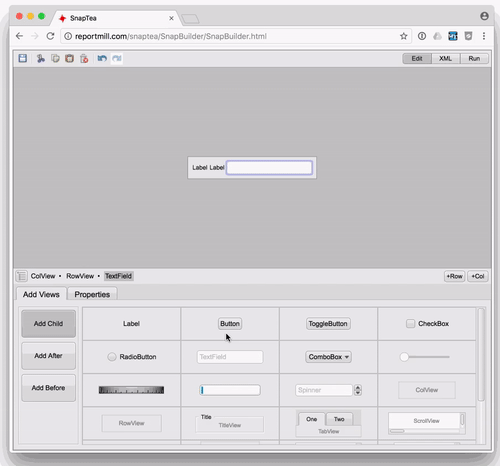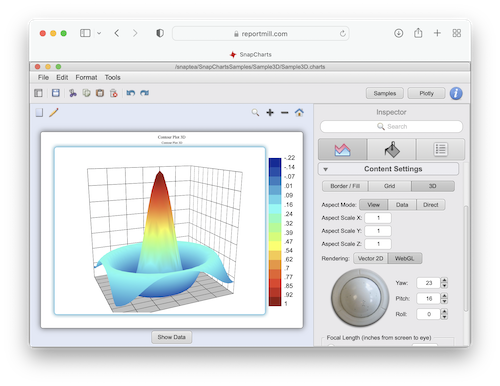README
SnapKit - a Java UI toolkit
SnapKit is a modern Java UI library + tools for creating rich Java Client applications that achieve the original promise of Java by running pixel-perfect and native on the desktop and in the browser (WORA).
Why do we need another UI kit? Because Swing is out of date, JavaFX missed the boat, and neither run natively in the browser. But Java desktop development is hard to beat: the iterative dev cycle is fast, debugging is powerful, refactoring is easy, and advanced dev tools solve many problems at compile time. The drawback is deployment: browser deployment is impossible to beat. This situation alone has led to the decline of Java Client adoption and prevented it from being a serious contender for most new development. SnapKit is designed to resolve this with no compromises.
Check out demos of SnapKit running in the browser:
Everything in its place
SnapKit runs optimally everywhere via a high level design where low-level functionality (such as painting, user input, system clipboard, drag-and-drop and windowing) is provided via interfaces to the native platform implementation. This makes SnapKit itself comparatively small and simple, light-weight and performant. When compiled to the browser (via TeaVM), many apps are only 1 MB in size.
So much to love about Swing
SnapKit is primarily inspired by Swing, still a favorite with remaining Java desktop developers, despite its age and lack of care and attention. Indeed, there are still many things to love about Swing:
Solid view hierarchy and set of controls/components
Relatively easy to create and update UI and respond to user input and UI changes
Full set of geometric shape primitives: Line, Rect, Ellipse, Path, Polygon, etc.
Easily set component borders, fills, and fonts with simple API
The whole convenient painting model - just override paint() to customize
It handles property changes in conventional Java property change manner
It binds easily with POJOs
And much to love about JavaFX
JavaFX rewrote the rulebook for Java UI by doing everything different. Still, there was much to love:
Easily mix graphics and app controls
Easily add gradients, textures, effects
Set arbitrary transforms (rotate, scale, skew) on any node
It has built-in binding support to easily wire values across objects
It has a full set of nodes for easy layout: Box, BorderView, StackPane, etc.
It has support for easily defining UI in a separate text file (FXML)
What's to love about SnapKit?
SnapKit tries to be more of a "Swing 2.0". More precisely, it keeps the basic simplicity and standard conventions of Swing while adding the visual richness of JavaFX and bringing the whole thing to the browser:
It provides all the most popular features of Swing and JavaFX (above)
It runs on top of Swing, JavaFX and HTML DOM
It is easily portable to any future UI kit and platform
The base class is called View. Now that puts the V in MVC!
The ViewOwner class provides control functionally (whoops, there goes the C)
The ViewEvent class unifies all input events for more consistent handling
The ViewOwner
Now here's the thing that really hurt Swing: There was no standard convention for the basics of UI management: Create, Init, Reset, Respond (otherwise known as a "Controller").
This resulted in confusing controller code, with UI controls often having code for all four functions in the same place. This is initially simple and attractive, but falls apart when dozens of inter-dependent controls are present and order-dependent updates are necessary.
Here is a simple Swing example that quickly gets out of control when extended to many properties and controls:
// Create UI
_textField = new JTextField();
// Init UI
_textField.setText("Initial Value");
// Respond/Update UI (TextField only)
_textField.addActionListener(event -> {
_myModel.updatePropertyForTextField(_textField.getText());
_textField.setText(_myModel.getPropertyForTextField());
});
Here is the same thing with a ViewOwner:
/** Create UI. */
public View createUI()
{
_textField = new TextField();
return _textField;
}
/** Initialize UI. */
public void initUI()
{
_textField.setText("Initial Value");
}
/** Reset UI. */
public void resetUI()
{
// Update TextField from Model
_textField.setText(_myModel.getPropertyForTextField());
}
/** Respond UI. */
public void respondUI(ViewEvent anEvent)
{
// Update Model from TextField
if (anEvent.equals(_textField))
_myModel.updatePropertyForTextField(_textField.getText());
}
Some things to note:
CreateUI() is usually handled automatically by loading a '.snp' UI file created in SnapBuilder.
InitUI() is also usually not needed, because UI is configured in createUI() and updated in ResetUI().
ResetUI() updates are deferred, coalesced and "protected" (will not cause respondUI() side effects) and is called automatically when the user interacts with any UI (or explicitly via resetLater()).
RespondUI() is called automatically by controls (they are preconfigured to do this by default)
ResetUI() and RespondUI() make tracking UI interactions convenient and easy by providing a consistent place to look for all get/set code between controls and the model.
ViewOwner "Universal Accessors"
As a convenience, ViewOwner will let you get/set values using standard methods and support all controls, which avoids having to lookup or remember specific get/set methods for controls. It also provides common type conversions to avoid tedious conversions to/from String/number/boolean formats.
public void resetUI()
{
// Update MyTextField, MySlider, ...
setViewValue("MyTextField", _myModel.getPropertyForTextField());
setViewValue("MySlider", _myModel.getPropertyForSlider());
...
}
The same applies to ViewEvent (the sole parameter to respondUI()):
public void respondUI(ViewEvent anEvent)
{
// Handle MyTextField, MySlider, ...
if (anEvent.equals("MyTextField"))
_myModel.updatePropertyForTextField(anEvent.getStringValue());
if (anEvent.equals("MySlider"))
_myModel.updatePropertyForSlider(anEvent.getFloatValue());
...
}
In addition to get/setViewValue(), there are methods for get/set other View properties: Enabled, Visible, Text, SelectedItem, SelectedIndex.
The Graphics Package
One of the great aspects of Swing is the separation and synergy between the core graphics layer (Java2D) and the UI layer. SnapKit provides this same separation with the snap.gfx package that contains:
Full set of geometric primitives: Rect, Point, Size, Insets, Pos (for alignment)
Transform for arbitrary transforms and coordinate conversions: rotate, scale, skew
Full set of Shape primitives: Rect, RoundRect, Arc, Ellipse, Line, Path, Polygon
Paint define fill styles with common subclasses: Color, GradientPaint, ImagePaint
Stroke for defining outline style, and Border for a stroke in a specific Paint
Effects for rich rendering: Shadow, Reflect, Emboss, Blur
Font and FontFile objects (wrap around platform fonts)
Painter capable of rendering shapes, images and text with transform, fill, stroke, effect
Image object (wraps around platform image)
RichText object for managing large text content with attributes
TextStyle object to manage a set of attributes: font, color, underline, hyper links, format, etc.
TextBox object for managing RichText in a geometric region (with spelling and hyphenation)
SoundClip for playing sounds
The View Package
And the essentail part of a good UI kit is the set of classes that model the scene graph and standard UI controls.
View for managing hierarchy of coordinate systems, drawing and input events
Full set of classes for graphics primitives: RectView, ShapeView, ImageView, StringView
Label: Convenient View+StringView+View layout to easily label UI
ButtonBase: Embeds Label for simple, flexible and customizable buttons
Button subclasses: Button, CheckBox, ToggleButton RadioButton, MenuButton, MenuItem
TextField for editing simple text values (with flexible background label for prompts, icons, etc.)
TextView: Comprehensive rich text editing with style setting, spellcheck, etc.
ComboBox, Slider, Spinner, ThumbWheel for modifying values with more advanced UI
ListView, TableView, TreeView, BrowserView for displaying large sets of objects
ParentView for Views that manage children (and ChildView for views that allow others to add them)
Box, VBox, HBox, BorderView, StackView, SpringView to facilitate layout
ScrollView, SplitView, TabView, TitleView
DocView, PageView: represent a real world document and page
ViewOwner: integrated controller class to manage UI creation, initialization, updates, bindings and events
RootPane: Manages view event dispatch and hierarchy updates, layout and painting
WindowView: Maps to a platform window
MenuItem, Menu, MenuBar
ProgressBar, Separator
ViewArchiver for reading/writing views from simple XML files
ViewEvent for encapsulating all input events in unified object
DialogBox, FormBuilder: For quickly generating UI for common user input
SnapBuilder for Building UI
Because the best line of code is the one you don't have to write, UI is almost always created using the UI builder and stored in simple XML files ('.snp' files). Simply create/save a .snp file with the same name as your custom ViewOwner class, and the default ViewOwner.createUI() method will load it.
As a bonus, you can run SnapBuilder in the browser and even open any UI file from a running application using the "Developer Tools Console", also available in any running app (see below).
Integrated Developer Tools
If you double-tap the control key in any SnapKit app, a developer console will appear. There are many features here to make it easier to debug visual layouts and explore new or large code bases:
Mouse-Over to select and inspect any individual nested ViewOwner controller and UI
Mouse-Over to select and inspect any View
Open any UI in the UI Builder, or controller in GitHub code, or View JavaDoc
Select different UI themes (standard, light, dark, light-blue, etc.)
Enable debug flashing of repaint regions to ensure efficient repaints
Enable Frames-Per-Second paint speed measurement tool
The 3D Graphics Package
SnapKit also has a basic 3D package based on OpenGL that uses JOGL on the desktop and WebGL in the browser. There is also a simple built-in renderer that renders 3D using standard 2D graphics (this avoids unnecessary external JOGL dependencies when 3D isn't really needed and can actually look better in PDF, SVG or print).
The 3D package has:
Basic geometry classes for matrices, vectors and points
Fundamental scene elements for Camera, Lights and Scene
Fundamental VertexArray class to model and render and mesh of triangles, lines and points




